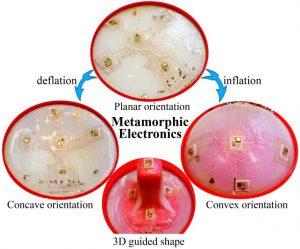Recent advancement in the field of electronics has taken a shift to enable the realization of mechanical stretchable electronic products. Mechanical stretchability is key to produce electronic systems, which morph to take on new form factors. However, current strategies have some limitations. For example, wrapping of a standard PET bottle with electronics would greatly benefit from stretchable electronics with a tailored localized stretchability to better adapt to the shape of the bottle. Similarly, the human skin has areas of low and high stretchability. In other words, it is desired to realize stretchable electronics with a tailored local elastic module to enable a more seamless integration with 3D shaped objects or objects which change shape. Such a technology would help to realise “metamorphic electronic systems”, which are electronic products that change shape.

A metamorphic microphone array, which morphs from a concave to a planar to a convex shape, and to many other complex geometries.
In their article published in Advanced Materials Technologies, a research group from Technical University of Ilmenau, Germany demonstrated a metamorphic microphone array, which morphs from a concave to a planar to a convex shape, and to many other complex geometries. The group reported a method to produce metamorphic integrated microphone arrays using a process, which is fully compatible with conventional printed circuit board technology, commercially available surface mount devices, and robotic mounting methods. The morphing array enables a better sound source localization when compared to existing static and planar arrangements. According to the article, a change in morphology has an enormous influence on the device functionality. To go further, it would be possible to adjust the morphology of the structure for the desired functionality in real time.
The concept of metamorphic acoustoelectronic arrays enables many new applications in the acoustic sensing. For example, one could potentially wrap a stretchable array of ultrasonic sensors and/or emitters around various 3D objects. Applications range from material to medical diagnostics, applications of ultrasound-based imagers achieving a new quality.
The future of metamorphic electronics is enormous. Fully developed, any electronic product known today may take on new 3D shapes and interesting form factors in the future. However, the field is young, and there is plenty of room for discoveries, development, and new architectures.
Kindly contributed by the authors.

















